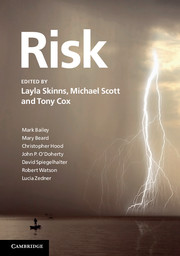Book contents
- Frontmatter
- Contents
- Figures
- Tables
- Acknowledgements
- 1 Introduction
- 2 Quantifying uncertainty
- 3 Decisions, risk and the brain
- 4 Risk and government
- 5 Risk and the humanities
- 6 Terrorism and counterterrorism
- 7 Risk and natural catastrophes
- 8 Risk in the context of (human-induced) climate change
- Notes on the contributors
- Index
- References
3 - Decisions, risk and the brain
Published online by Cambridge University Press: 05 June 2012
- Frontmatter
- Contents
- Figures
- Tables
- Acknowledgements
- 1 Introduction
- 2 Quantifying uncertainty
- 3 Decisions, risk and the brain
- 4 Risk and government
- 5 Risk and the humanities
- 6 Terrorism and counterterrorism
- 7 Risk and natural catastrophes
- 8 Risk in the context of (human-induced) climate change
- Notes on the contributors
- Index
- References
Summary
The ability to make good decisions about future courses of action under conditions of uncertainty is essential for the survival of most animals, including humans. Whether it is deciding which item to choose from a restaurant menu, when to cross a busy road or what career path to follow, we are constantly faced with the need to make decisions of varying degrees of importance in terms of their implications for our future well-being. Often the outcomes of such decisions are highly uncertain, and we must therefore take into account not only the pros and cons of the outcomes associated with different courses of action but also the uncertainties or ‘risk’ attached to such outcomes. On the whole, humans are rather good at making decisions, as exemplified by our incredible success as a species. The root of that success necessarily lies in the machinery contained in our brain, a highly efficient computer weighing approximately 1.36 kg that has been shaped by evolution to allow us the flexibility to make good decisions in diverse and rapidly changing environments. In this chapter, I will give a broad introduction to a new interdisciplinary field of study called ‘neuroeconomics’, which is concerned with elucidating how the brain is capable of enabling us to make such good decisions. I will outline our current understanding about how decisions are made by the brain, and I will highlight some of the outstanding questions for future research in this still nascent field of study.
Neuroeconomics
The field of neuroeconomics has emerged through a fusion of approaches found in more traditional disciplines. These include not only neuroscience and economics, as one might have guessed from the perhaps clumsily put-together title, but also cognitive and behavioural psychology, computer science and artificial intelligence, engineering, robotics and behavioural ecology, among others (Glimcher et al., 2009). A core assumption behind neuroeconomics is (in common with much if not all contemporary neuroscience) that the brain can be treated as a computational device transforming input in the form of information reaching our sense organs (vision, touch, audition, smell and taste), into output in the form of the generation of behaviour. This transformation is mediated by the billions of highly interconnected neurons (nerve cells) contained in our brains. The main goal of neuroscience is to describe precisely how these neurons act on the incoming sensory information in order to produce a particular output, or, to return to the brain-as-computer analogy, to resolve the algorithms (or mathematical functions) used by the brain to achieve such transformations.
- Type
- Chapter
- Information
- Risk , pp. 34 - 61Publisher: Cambridge University PressPrint publication year: 2011

